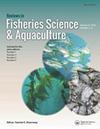Development of Captive Breeding Techniques for Marine Ornamental Fish: A Review
引用次数: 99
Abstract
The increasingly popular aquarium hobby is fueling the rapid growth of the aquatic ornamental industry, particularly the trade of marine ornamental species. However, currently there is a heavy reliance on wild caught marine ornamentals to satisfy consumer demand. As public awareness of the plight of marine ecosystems grows, the often destructive and unmanaged exploitation of coral reefs for the marine ornamental trade has raised concerns. Therefore, there is consensus that urgent actions need to be taken to limit destructive exploitation of coral reefs, and to ensure the sustainability of the marine ornamental industry. An obvious and vital action of such efforts would be the development of captive breeding techniques for marine ornamental species, in particular, coral reef fish. Research efforts towards captive breeding of marine ornamental species, also known as marine ornamental aquaculture, stand to supplement or replace the supply of wild caught specimens for the marine ornamental trade, and potentially help boost reef recovery efforts through restocking. However, unfortunately, the marine ornamental aquaculture sector is still in its infancy, receiving limited research attention, and, in turn, has experienced very slow development compared to the technical and industrial advances made in foodfish aquaculture. While it is true that at present, multiple bottlenecks have severely limited the progress of marine ornamental aquaculture, through careful appraisal and adaptation of culture techniques developed for foodfish, and by addressing the specific needs of marine ornamental aquaculture, significant progress could be made for the marine ornamental aquaculture industry. With this objective in mind, this review attempts to summarize the major bottlenecks facing the marine ornamental aquaculture industry, and to highlight weaknesses in the current state of research. Major areas in need of increased research efforts include broodstock management, such as the development of specific broodstock diets and broodstock husbandry, spawning induction via hormone technologies that are tailored to the size and sensitivity of small broodstock ornamentals, and comprehensive, species-specific larval rearing techniques, including system design and larval culture conditions as well as larval feeds and nutrition.海洋观赏鱼圈养养殖技术研究进展
越来越受欢迎的水族馆爱好正在推动水生观赏产业的快速增长,特别是海洋观赏物种的贸易。然而,目前人们严重依赖野生捕捞的海洋观赏动物来满足消费者的需求。随着公众对海洋生态系统困境的认识日益加深,为了海洋观赏贸易而对珊瑚礁进行的破坏性和无管理的开采引起了人们的关注。因此,人们一致认为,需要采取紧急行动,限制对珊瑚礁的破坏性开发,并确保海洋观赏产业的可持续性。这种努力的一个明显而重要的行动将是发展海洋观赏物种,特别是珊瑚礁鱼类的圈养繁殖技术。研究海洋观赏物种的圈养繁殖,也被称为海洋观赏水产养殖,可以补充或取代海洋观赏贸易的野生捕捞标本供应,并有可能通过重新放养来促进珊瑚礁恢复工作。然而,不幸的是,海洋观赏水产养殖部门仍处于起步阶段,得到的研究关注有限,与食用鱼水产养殖的技术和工业进步相比,其发展速度非常缓慢。虽然目前存在诸多瓶颈严重限制了海洋观赏水产养殖的发展,但通过对食用鱼养殖技术的认真评估和适应,并通过解决海洋观赏水产养殖的具体需求,海洋观赏水产养殖业可以取得重大进展。基于这一目标,本综述试图总结海洋观赏水产养殖业面临的主要瓶颈,并突出当前研究状态中的弱点。需要加强研究工作的主要领域包括:种鱼管理,例如开发特定的种鱼饲料和种鱼养殖;通过适合小型观赏种鱼大小和敏感性的激素技术诱导产卵;以及综合的、特定物种的幼虫饲养技术,包括系统设计和幼虫养殖条件以及幼虫饲料和营养。
本文章由计算机程序翻译,如有差异,请以英文原文为准。
求助全文
约1分钟内获得全文
求助全文

 求助内容:
求助内容: 应助结果提醒方式:
应助结果提醒方式:


